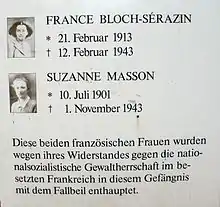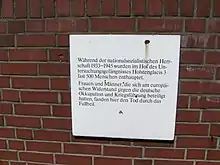France Bloch-Sérazin
France Bloch-Sérazin (French pronunciation: [fʁɑ̃s blɔʃseʁazɛ̃] (![]() listen); (21 February 1913 – 12 February 1943) was a chemist and militant communist who fought in the French resistance against German occupation during World War II.
listen); (21 February 1913 – 12 February 1943) was a chemist and militant communist who fought in the French resistance against German occupation during World War II.
France Bloch-Sérazin | |
|---|---|
| Born | France Bloch 21 February 1913 |
| Died | 12 February 1943 |
| Cause of death | Execution |
| Alma mater | University of Poitiers |
| Spouse(s) | Frédéric (Frédo) Sérazin |
| Children | Roland, b. January 1940 |
| Parents |
|
| Honours | Legion of Honor, Resistance Medal, War Cross |
Biography



Born in Paris into a Jewish family, she was the daughter of the writer Jean-Richard Bloch (1884-1947) and Marguerite Herzog (1886-1975) who was sister of the writer André Maurois.[1] France Bloch was initially a student in the countryside near Poitiers, France where she obtained a degree in chemistry after having hesitated between chemistry, literature and philosophy. In October 1934, she began working at the laboratory of Professor Urbain at the National Institute of Chemistry. She joined the Communist Party in Paris, becoming involved in the support of the Spanish Republicans who were fighting fascism there.[1]
Bloch married Frédéric Sérazin, nicknamed Frédo, in May 1939. He was a militant communist and metallurgist, with whom she had a son named Roland, born in January 1940.[1][2]
After the installation of the Vichy regime, Bloch was barred from her laboratory because she was a Jewish communist and had to work as a tutor in order to survive. In 1941, she participated in the first groups of the communist resistance led by Raymond Losserand and installed a small, rudimentary laboratory in her two-room apartment on the Place du Danube located in the 19th arrondissement in Paris. Taking the name Claudia in hiding, she worked with Colonel Dumont making grenades and detonators used in attacks organized by the youth resistance (called the Young Battalions) at the end of August 1941.[1][2][3]
Bloch was arrested by the French police on 16 May 1942. After four months of interrogation and torture, she was condemned to death by a German military tribunal, along with 18 co-conspirators (who were all immediately executed). Meanwhile, Bloch herself was deported to Germany and imprisoned in a fortress at Lübeck. She was subjected to further torture there, and was decapitated by guillotine in Hamburg on 12 February 1943.[1]
In her last letter to her husband before her execution, France Bloch Sérazin wrote: "I die for what we fought for, I fought; you know like me that I could not have acted other than I acted: we cannot change.”[3] Her husband would be executed in 1944.
On the site of the Hamburg prison, a plaque on the back wall of the detention center commemorates two members of the Resistance who were killed there.[4] A translation of the inscription reads:
France Bloch-Sérazin, 21 February 1913 -- 12 February 1943
Suzanne Masson, 10 July 1901 - 1 November 1943
These two French women were beheaded with a guillotine in this prison because of their resistance to National Socialist tyranny in occupied France.[4]
Bloch family
Bloch's husband, Frédo Sérazin was arrested in February 1940, under the Daladier government, imprisoned first at the Sisteron fortress in March 1940, then at Châteaubriant, and finally at the Voves camp. He was assassinated by the German militia or the Gestapo in 1944 in Saint-Etienne, France.[1]

France Bloch's paternal grandmother, Louise Laure Marie Lévy Bloch, was born in Carling (near the France-German border) on 15 June 1858. On 12 May 1944, she was arrested by the Gestapo in a roundup in Néris-les-Bains and was interned in Vichy, France. She was transferred on 26 May 1944 to the camp near Drancy and received registration number 23255. Despite her advanced age (about 86), she was reportedly a model of energy, confidence and strength. On 30 May 1944, she was deported to the German concentration camp Auschwitz in convoy number 75. She died there on 4 June 1944. A plaque listing the deportees who died for France can be found at the Monument to the Dead in Néris-les-Bains, France; it bears her name.[1]
Honors
Posthumously, France Bloch-Sérazin was awarded the Legion of Honor, the Resistance Medal, and the War Cross.[2][3]
A street was named after her in Blanc-Mesnil, Poitiers, Vierzon, as well as a square in Cognac.[1][5]
References
- "France Bloch-Sérazin", Wikipédia (in French), 2019-09-08, retrieved 2019-12-16
- "France Bloch Serazin". Mémoire et Espoirs de la Résistance (in French). Retrieved 2019-12-16.
- "Bloch-Sérazin France — Commemorative Plaque in France" (in French). 2011-07-25. Archived from the original on 2011-07-25. Retrieved 2019-12-16.
- "Bilder von Hamburg - Fotos von den Wallanlagen / Hamburg". www.bildarchiv-hamburg.de. Retrieved 2019-12-16.
- "www.lanouvellerepublique.fr/poitiers/france-bloch-serazin-bientot-honoree-par-la-ville". lanouvellerepublique.fr (in French). Retrieved 2019-12-16.
External links
- (In French) Dernière lettre de France Bloch-Sérazin de la prison de Hambourg où elle a été guillotinée. La lettre a été expédiée grâce à la gardienne de la prison. (In English: Last letter by France Bloch-Sérazin from prison.)
- (In German) "Die französische Widerstandskämpferin France Bloch-Sérazin" ("France Bloch-Sérazin, membre de la Résistance")
- (In German) Plaque commémorative à Paris et film de Loretta Walz. (In English: Commemorative plaque in Paris and film by Loretta Walz.)
- (In French) Jean Omnes, Nicole Racine, article "France Bloch" in Dictionnaire biographique du mouvement ouvrier, Editions ouvrières, 1997.
- (In French) https://www.humanite.fr/portrait-france-bloch-un-amour-sur-fond-de-resistance-657001
- (in French) Group Operations: https://www.resistance-ftpf.net/chimie/operations.html
| Wikimedia Commons has media related to France Bloch-Sérazin. |